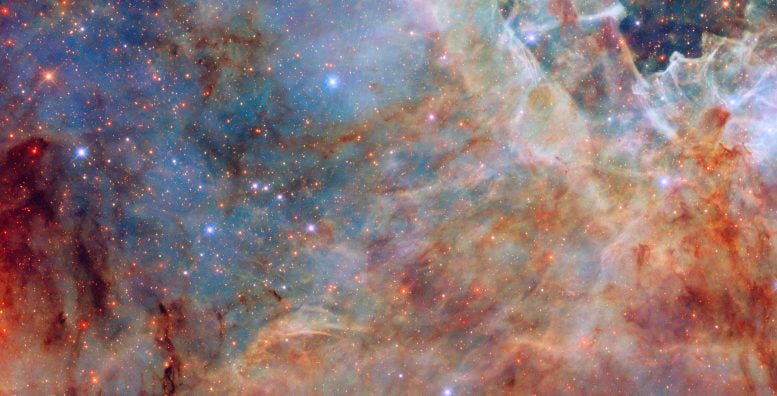Dive into a celestial masterpiece with the Hubble Space Telescope’s latest snapshot of the Large Magellanic Cloud, showcasing the Tarantula Nebula’s vibrant star-forming regions.
Amidst serene blue gas and colorful stars, learn how cosmic dust influences star and planet formation.
Today’s Hubble Space Telescope image showcases a stunning cosmic scene filled with dust and starlight from the Large Magellanic Cloud, one of the Milky Way’s satellite galaxies. This dwarf galaxy, located about 160,000 light-years away in the constellations Dorado and Mensa, is much smaller than our own Milky Way but still holds remarkable celestial wonders.
Stellar Giants in the Tarantula Nebula
Although the Large Magellanic Cloud has only 10-20% of the Milky Way’s mass, it contains some of the most spectacular star-forming regions in our cosmic neighborhood. The featured image captures a section on the outskirts of the Tarantula Nebula, the largest and most active star-forming region in the nearby Universe. At its core, the Tarantula Nebula harbors the most massive stars ever discovered, each weighing around 200 times more than our Sun.
Colors of Creation: Blue Gas and Red Stars
The section of the nebula shown here features serene blue gas, brownish-orange dust patches, and a sprinkling of multicolored stars. The stars within and behind the dust clouds appear redder than those that are not obscured by dust. Dust absorbs and scatters blue light more than red light, allowing more of the red light to reach our telescopes and making the stars appear redder than they are.
Advancing Astrophysics Through Hubble’s Eyes
This image incorporates ultraviolet and infrared light as well as visible light. Using Hubble observations of dusty nebulae in the Large Magellanic Cloud and other galaxies, researchers will study these distant dust grains, helping to understand the role that cosmic dust plays in the formation of new stars and planets.





